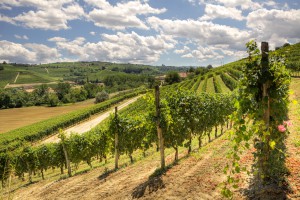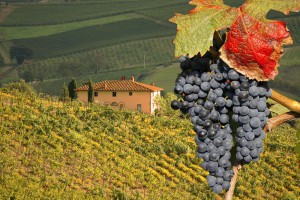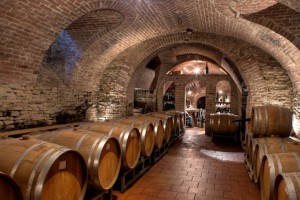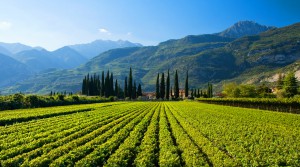
A View From a Northern Italian Vineyard
If I were forced to drink wines from just one nation for the rest of my days, I would, without hesitation, choose the wines of Italy. Luckily, I don’t have to make such a choice, but if I were forced, the decision would be an easy one.
The wines of Italy are incredibly diverse in every respect. If you like wine, there is an Italian wine for you (likely dozens of wines). Old and new winemaking techniques utilizing grapes seldom seen outside of Italy conspire to create wines like no others.
Italy’s 20 regions from north to south including the island, produce wines of distinction. You can find dry and sweet, sparkling wines made using the Champagne method, as well as cheap and cheerful Prosecco, incomparable whites, and red wines ranging from simple and quaffable to magically complex.
In the North, you can find white wines that are every bit as crisp and sleek as anything found in Austria and Germany, and in the South, you will be treated to reds as lush and juicy as any Australian Shiraz. Again, if you like wine and you don’t have a favorite or set of favorite Italian wines you need to do some more exploration.
It’s important to remember that the nation of Italy was not unified until 1861. Before unification, Italy was a collection of sovereign and often unfriendly states, each with a unique language, culture, cuisine, and distinct wines. Not until post World War II was the Italian language officially used in each region. Every part of daily life was tied to the region state. Their cuisine grew from the land and the sea and their wines from the omnipresent vines that grew natively or had been introduced long ago by the Romans, Greeks, or the Etruscans.
Like the French with their AOC and the Spaniards with their DO, the Italians too have their own set of regulations known as the Denominazione di Origine Controllata or simply, DOC. These rules manage the grape varieties permitted for use within a particular DOC, as well as minimum alcohol levels, aging requirements, and sometimes the maximum yield of grapes per acre. The Italians created their DOC appellation system in the early 1960s making many modifications along the way. A major revision in 1980 created the DOCG category, that is reserved for the highest quality wines and later, the IGT was created to recognize quality wines that did not fit into existing DOC rules but were clearly superior to Vino da Tavola (VdT) wines, which is a base classification for simple table wines.
It is not at all cynical to suggest that the IGT classification is, in fact, the “Super Tuscan” rule.

Chianti Grapes
What are Super Tuscans? Many Italians would ask the same question as this is very much an Anglo term used by wine writers and merchants since the late 1970s and popularized in the 90s and beyond. The term was coined as there were a number of high quality wines, with hefty price tags to match, being made by Tuscan wine producers that did not conform to the DOC rules. By law, these wines had to be labeled as VdT (table wines), which was a bit farcical as all recognized these simple table wines as being some of the greatest wines made in Italy.
Famously Sassicaia, made by Tenuta San Guido, is considered the first of the Super Tuscans, with its first commercial release in 1971. Sassicaia is a Bordeaux-style wine (made with Cabernet). Eventually, the rules committee caught up and created the appellation of Bolgheri DOC in 1994, along with Sassicaia being granted its very own DOC the same year.
Most of the world’s winemakers would have conformed in order to use the famous appellation names on their labels but the Italian winemaker is a different breed. The constantly changing set of regulations and appellations in Italy is formed greatly by the passion and stubborn nature of the Italian winemaker who frequently strives to produce the best he or she can damn the regulators if need be.
The best way to tackle Italian wines is region by region, as each region has unique wines to offer. Examining all 20 regions today would be overwhelming, but how about the highlights of six regions?
Let this be your starting point, and don’t be discouraged if mastering the subject proves to be tricky. Many professionals in the wine industry are confused to some degree by the vast number of wine zones and grape varietals. After decades of digging into Italian wines, I learn new things every month.
Here are Six Italian Wine Regions Presented North to South
Piedmont is the home of the world-famous appellations of Barolo and Barbaresco. These wines grace the wine lists of the world’s finest restaurants and occupy space on every wine lover’s top shelf. Both Barolo and Barbaresco are made solely with Nebbiolo, one of the great noble grapes. These wines are among the very finest wines made in the world and among Italy’s most expensive wines. Barolo and Barbaresco are best cellared as in their youth as they often conceal their depth and character.
While Nebbiolo is all glitz and glam, Barbera is Piedmont’s heart and soul. Barbera is both fruity and rustic, with prominent earth and herbal notes. The styles vary greatly depending on the soils, temperatures, and sun exposure. The cooler the zone, the more austere the wine, while hotter temperatures create bigger, jammy wines.

An Italian Wine Cellar
The third most important red varietal in Piedmont is Dolcetto. It is the most delicate of the three, with lower acidity but firm tannins. Arguably, the best Dolcetto is made in the DOCG zones of Dogliani and Dolcetto di Diano d’Alba.
While certainly secondary to the reds, Piedmont does produce some delicious white wines. The charming and lush wines made from Arneis are most familiar to export markets. Most famously, the DOCG of Roero produces Arneis with exotic fruit flavors that are best enjoyed by young. The second white wine of note is made from Erbaluce and is most famously expressed in Erbaluce di Caluso. Erbaluce produces crisp wines with a generous dose of acidity and flavors of green apple, citrus, fresh herbs, and bright floral notes.
Veneto, in the eye of the world traveler, is home to Venice, the charming city of islands linked by canals and bridges. There really is nothing like Venice, and it should be on everyone’s bucket list. The wine lover has another reason to visit Veneto, even if it’s from their own kitchen. Veneto offers superb red, white, and sparkling wines. In sum, there are 14 DOCG zones in Veneto, so there is no shortage of quality wines to be found in the Northeastern Italian region.
Red wines are king here, but white and sparkling wines are certainly famous and are not to be missed. Chief among whites is Soave, a bright and deceivingly complex wine based on the ancient Garganega grape that is grown nearly exclusively in Veneto. Do you want bubbly? There is hardly a wine drinker on the planet who has not heard of Prosecco, the cheap and cheerful sparkling wine made from the Glera.
Veneto’s greatest red is Valpolicella, in all its glorious forms. Valpolicella is made primarily with Corvina. Corvina produces wines with bright flavors of blackberry and cherry with herbal and mineral notes in support. The Valpolicella DOC offers a superb example of what Corvina can be. A specialty version of Valpolicella known as Valpolicella Ripasso is made by combining finished Valpolicella wines with the still active, unpressed grade skins used when making Amarone della Valpolicella DOCG. The most noble expression of Valpolicella is Amarone della Valpolicella. Amarone is made with grapes that have partially dried, intensifying alcohol and flavor. These wines can age for decades and are among the most coveted wines in the world.
Tuscany is a picturesque region with rolling verdant hills, jutting hill towns, and of course, vineyards. Tuscany is home to Italy’s best-known wine export, Chianti. Thanks to years of filling export markets with uninspiring wine, Chianti earned a reputation as being cheap and ordinary. Nothing could be further from the truth, as Chianti is one of the world’s great red wines. Chianti is made primarily with Sangiovese, Italy’s most planted varietal and Tuscany’s signature grape.
Sangiovese is one of the world’s noble red grapes. In addition to Chianti, it is responsible for most of Tuscany’s great reds, such as Brunello di Montalcino, Vino Nobile di Montepulciano, and Carmignano, among many others. Among these, Brunello is king, commanding the greatest prices while still being a relative bargain among the world’s greatest red wines. Brunello di Montalcino is made in the vineyards surrounding the hillside town of Montalcino. The DOCG zone is rather small, and most producers produce less than 3,000 cases of Brunello a year.
Like Brunello, Vino Nobile di Montepulciano is made in sloping vineyards surrounding a hillside town, Montepulciano. In fact, the vineyards must be at a minimum elevation of 250 meters. The DOC was established in 1966 and rightfully elevated to DOCG when that quality designation was created.
Of course, there are also white wines made in Tuscany, chief among them being Vernaccia di San Gimignano DOCG. As the name suggests, the wines are made from Vernaccia in and near the hill town of San Gimignano. These wines are crisp and fruity, with great mineral notes and bright acidity.
Abruzzo, just east of Rome along the Adriatic, is known as the “greenest” region in Europe as one-third of its land is national and regional parks that are home to rare species of birds, wolves, and bears. It’s also home to one of Italy’s most congenial wines, Montepulciano d’Abruzzo. Montepulciano is a great and versatile red varietal grown throughout central and southern Italy. It is pleasingly fruity with bright cherry notes, but well-made examples also feature a slightly rustic note of dried berries, fresh herbs, and exotic baking spices. Montepulciano d’Abruzzo is one of the rare wines that thrill both the novice and experienced Italian wine drinker. If the charming flavors aren’t enough, it is often a great value, selling for under $20 a bottle.

Beautiful Morning in an Italian Vineyard
Campania is a beautiful region hugging the Mediterranean Coast south of Rome. This is the home to Naples, Pompeii, and arguably the spiritual home of pizza. Campania is also home to a set of very expressive wines from the rich reds of Taurasi made primarily with Aglianico and a trio of white wines made from ancient grapes such as Falanghina, Fiano, and Greco. These grapes are hardly household names, but just two decades ago, they were in danger of going extinct. Falanghina is a wonderfully exciting wine in the glass, offering a range of rich flavors from peach to tropical fruits and citrus with mineral and herbal notes as well. It has a flavor all its own and offers a great break from an endless stream of Chardonnay, Sauvignon Blanc, or Pinot Grigio.
Sicily, like many Italian regions, is in a great period of change as ancient varietals are now in fashion, and the wines at large are better than ever. Luckily, many value options from Sicily, from the vibrant whites made with the native Inzolia (aka Ansonica) to the rich and jammy reds based on Nero d’Avola (aka Calabrese). Sicily’s only DOCG, Cerasuolo di Vittoria, is made primarily with Nero d’Avola, as with several additional DOC wines. Prices range from $8 to $40 a bottle while there are many delicious examples being sold for well under $20.
Beyond Nero d’Avola, some very compelling wines are being made near Sicily’s Mount Etna. Red wines made from grapes that few have heard of, such as Nerello Mascalese and Carricante, are remarkably complex and delicious. Look for this rather large DOC to be subdivided into several smaller DOCs and perhaps a DOCG or two in the coming years.
Bonus Italian Wine Region Data
Emilia Romagna – located in northern Italy, its capital city is Bologna. This region is a food lovers paradise, and the wines play a supporting role here. Lambrusco is the star, while the beautiful Romagna Albana is among the world’s greatest dessert wines.
Friuli–Venezia Giulia – located in northeast Italy, is known primarily for its crisp and low alcohol white wines as well as Prosecco. The wines are often labeled with the varietal name taking center stage on the front label.
Lazio – is dominated by Italy’s capital city of Rome. For many decades, Lazio wines were cheap and cheerful, but not much more. Thanks to the steady rise of Cesanese, a local red varietal with great promise, and the rebirth of Frascati, Lazio is now a bona fide wine destination.
Lombardia – is in the middle of Italy’s northernmost regions. While fashion-lovers focus on the capital city of Milan, we are in love with the classic-method sparkling wines of Franciacorta. Also, don’t sleep on the great Nebbiolo wines made in Valtellina that can rival the wines in neighboring Piedmont.
Marche – is a great agricultural region located in central Italy along the Adriatic. The wines are rising in popularity with Rosso Conero (and Conero DOCG) and Rosso Piceno, both based on the grape Montepulciano, leading the reds and surprisingly complex whites made from Verdicchio. Offida is an appellation on the rise producing DOCG varietal whites made from Pecorino and Passerina and a Rosso made from Montepulciano.
Puglia – forms the heel of the famous boot, and it quietly offers 4 DOCG and 28 DOC zones. Reds dominate here, relying on Sangiovese, Primitive, Negroamaro, and the soon-to-be-famous Bombino Nero.
Umbria – borders Tuscany in central Italy and is perhaps too figuratively shadowed by its famous neighbor. The very tasty whites from Orvieto (made from Grechetto and Trebbiano) are often a great value. However, the stars in Umbria are two red wine DOCG zones: Torgiano Rosso Riserva (based on Sangiovese) and Montefalco Sagrantino, made entirely with Sagrantino. Both of these great wines deserve more attention.

Well written!!
Thanks. Finally there is one simple article that gives a broad overview of Italian wine. I find Italian wine to far trickier than French wines that I know well.
Cool and thanks. I have to be more adventurous
Great read Sean! Grazie Mille!
Thanks a million Lisa!